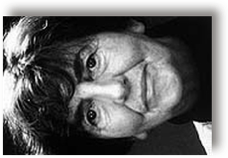
Design:
Christine Bünning
05.2025
UNGEHALTENE FRAUEN
based on a book of CHRISTINE BRÜCKNER
modeled on textile art by Christine Bünning
IDEA for this project
In her book “If you had talked, Desdemona,” Christine Brückner invented monologues for female characters from history, literature and mythology as they could have been delivered. Because these women would definitely have had something to say! But unfortunately almost exclusively famous speeches by famous men have survived...
I dealt with these and other women and staged the content of the angry speeches in textiles.
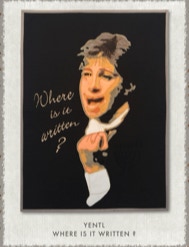
The film character Yentl, the Jewish girl from Eastern Europe, is secretly instructed in the teachings of the Talmud by her father after her mother's death, which is forbidden according to most Hasidim. After her father's death, she disguises herself as a man in order to study at a yeshiva, a religious school... In constant conversation with God, she searches for answers to the questions that torment her about the meaning of things and rules: “Where is it written? “What should I be?”
Dimensions: 65 x 48 cm

Actually, Maria - or rather Miriam - is just a simple woman... What was prophesied to her remains a miracle for her. For her the Son is not their own flesh and blood, he is the Son of God. She turns to God questioningly, asking about meaning and non-sense, about faith and knowledge...
Dimensions:
74 x 56 cm
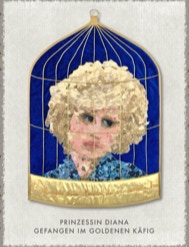
“There’s just no one I can yell at. Or someone who will hold me in his arms - just listen to me when I cry.” (Original quote) The Queen of Hearts - a sad fairy tale! Trapped in a golden cage!
Dimensions:
74 x 50 cm
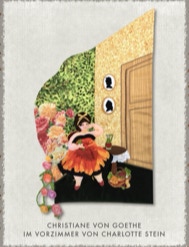
Suppose that the unsuitable Christiane von Goethe, née Vulpius, had wanted to explain herself in her old age and "make things clear" with Charlotte von Stein, Goethe's muse and enthusiastic lover... but the aloof lady-in-waiting lets Goethe's wife sit unheard in the anteroom .... With every glass of the liqueur that was available, another grain of simple truth would be known... This is how she introduces herself “as Goethe's fatter half”. She could never deny her humble origins and lack of education, but she meant a warm home to her husband, which he clearly enjoyed.
Dimensions:
62 x 38 cm (irregular shape)
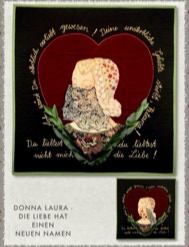
It is the supposed speech of Donna Laura (Laura de Noves), who was suffering from the plague, to the escaped Petrarch, poet and historian. Its name is based on the term Petrarkism, which describes a style of European love poetry that was widespread until the 17th century. He first met Donna Laura when she was 16 years old. Her impression was so strong on him that he admired her throughout his life as an ideal female figure and a lasting source of his poetic inspiration, knowing and accepting that she was unattainable for him. As a poet, he sought fame and laurels (Latin laurus) and found a means to achieve this in Laura. But his great platonic love dies out when the woman he loves falls ill with the disastrous and disfiguring plague.
Dimensions:
58 x 57 cm
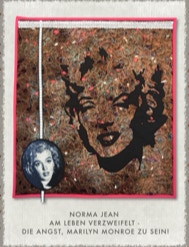
Quote: “A sex symbol is a thing, and I hate being a thing!” As an unwanted child, she was given away twelve days after her birth, grew up with foster parents and in an orphanage, was raped for the first time at the age of 12 Married at 16 years to avoid another orphanage... three failed marriages, unfulfilled desire to have children, illnesses, alcohol and drug addiction, psychiatric treatments... huge successes and awards... but unhappy. Her greatest wish since childhood was to become an actress. However, she always aspired to the character subject. Instead, she was made into a film icon and sex symbol of the 20th century. She wrote diaries and lyrical poems that provide a glimpse into her true personality.
Dimensions:
64 x 59 cm
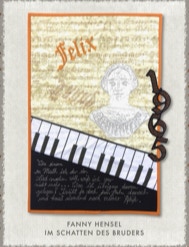
Fanny Hensel was a German Romantic composer whose complete works - with a few exceptions - were only entrusted to the Prussian Cultural Heritage Foundation in 1965, more than a hundred years after her death. Her family largely prohibited her from pursuing a musical career and publishing of her compositions during her lifetime. At least as talented as her brother Felix Mendelssohn, she created more than 450 compositions - a fraction of which Felix Mendelssohn had printed under his name.
Dimensions:
65 x 43 cm
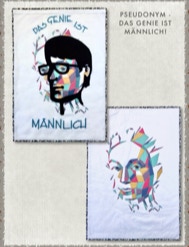
For centuries, women have been tempted or forced to have their art marketed by men or to adopt a male or gender-neutral pseudonym. Women have long been denied the power of their own creativity. It is not for nothing that one of the guiding principles of the 19th century was “Genius is male”. Because women were not believed to have this ability, they retreated into anonymity and so often found themselves dependent on their fathers, husbands or other “patrons”.
Dimensions: 70 x 50 cm

Turning to her deaf dog Rollo, Effi (the protagonist of Theodor Fontane's novel) explains and complains about her messed up life. Always the wild child - no one ever prepared her for life as an adult woman - always patronized and completely misunderstood... So everyone responds to her with a head-shaking "But Effi!"
Already terminally ill, she - still begging for understanding - tries to explain herself to her husband.
Dimensions:
65 x 54 cm
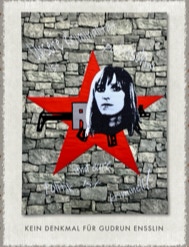
The evening before her suicide, Gudrun Ensslin speaks against the walls of the prison cell. Still firmly convinced of the idea that something needs to be changed in the system... This is more important to her than, for example, being a good mother... She fights for her beliefs until the end - but by what means?!
Dimensions:
62 x 45 cm
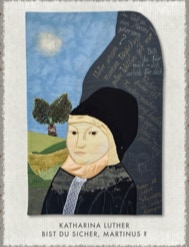
The wife of the great reformer Martin Luther openly puts her thoughts on the table here, puts Bible verses and sermon texts into her own words or questions them... She always had an optimistic eye on life and organized everything to make life possible for her husband and to provide the framework in which he could master his life and distinguish himself as the great reformer.
Dimensions:
60 x 40 cm
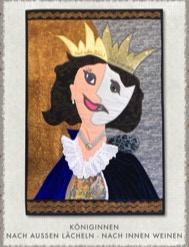
An article in BILD with the title “Smiling on the outside - crying on the inside” inspired me to create this illustration. He reported on Queen Silvia of Sweden and the shadows of the fairy tale of being queen... about her husband's affairs, the fears of failure and the worrying state of health of the daughter, the worries about the mother, who suffers from dementia... This motif can certainly be described project onto many fellow sufferers, royal “colleagues”... Despite all life circumstances, annoyances, suffering and all sorrow, one must maintain one's posture and always present a royal smile!
Dimensions:
79 x 53 cm
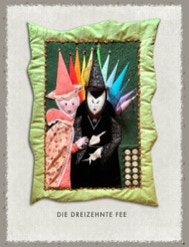
Who doesn't know the fairy tale of Sleeping Beauty and the thirteenth, evil fairy who appears in it? But what actually makes her so angry? That the dozen, the duodecimal system is so important to us humans? The number of place settings at the table determines the number of guests at the big party. If that's not a reason to be upset?! Out of sheer anger at this disregard, the thirteenth fairy imposes a killing curse, which can then be alleviated by the twelfth fairy. A big thought game about the number 13.
Dimensions:
108 x 80 cm
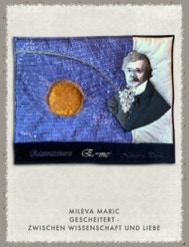
She was the first Serbian and one of the first women ever to be admitted to study mathematics and physics at the Zurich Federal Polytechnic in 1896. There she studied alongside Albert Einstein, with whom she researched and learned with great enthusiasm. This common interest gave rise to a great love, which, however, only lasted until Einstein achieved a certain level of success. Among other things, they worked together on the theory of relativity, for which Einstein later received the Nobel Prize. He wanted to claim everything that the two of them had explored together for himself and for his success. He rejected her, left her and the children and looked for “less demanding” women.
Dimensions:
61 x 76 cm
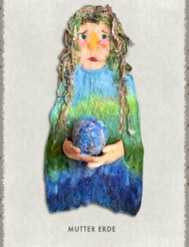
Mother Earth, an elderly fairy godmother, looks sadly at her globe. The poles melted, the continents brown and withered, plastic in the seas, forests cut down and burned, countless flight paths and an ozone layer in shreds... What will become of it and of us?
Dimensions:
100 x 50 cm
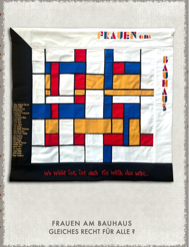
When Walter Gropius opened the state-run Bauhaus in Weimar in 1919, he announced in the program: “Any person in good standing, regardless of age and gender, whose talent and previous training is considered sufficient by the master council will be accepted as an apprentice.”
Attracted by the visionary character of this school and the opportunity to learn a practical profession, many women enrolled. But Gropius soon feared that the large number of women would damage the school's reputation. He recommended that “no more unnecessary experiments” be carried out and called for “sharp segregation immediately after admission, especially in the case of the female gender, which is too strongly represented”. The masters feared that female students would take away valuable workshop space from male students and pushed women into the weaving workshop. Oskar Schlemmer later coined the verse in Dessau: “Where there is wool, there is also a woman who weaves, even if it is just to pass the time” and with his mockery he hit the core of the prejudices that had already led to them in Weimar Weaving was declared a “women’s class” from 1920 onwards. Nevertheless, some Bauhaus women achieved success and fame - also in other artistic areas. Some of them are listed on the left edge of the picture.
On the one hand, the women at the Bauhaus couldn't be persuaded to enroll in this new school... but they were certainly also very angry about the obvious unequal treatment.
Dimensions: 90 x 85 cm
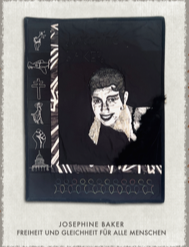
Josephine Baker has been inspiring people for over a hundred years. By dancing, she freed herself from the slums of the American South and conquered the stages of the world. After experiencing massacres against black people as a child, she made the fight against racism and for freedom and equality her life's work. She used her fame to raise her voice. During World War II, Baker worked for the Red Cross and supported the Resistance. She collected and smuggled information for the French government-in-exile of General Charles de Gaulle and the Allies. To entertain the troops, she traveled in a military jeep as a lieutenant in the Free French Air Force and donated the proceeds from her concerts. After 1945, Josephine Baker returned to the stage - as an ambassador for peace, freedom and equality for all people regardless of nationality, skin color or religion. There was no racial segregation in her concerts around the world; as a star she enforced this condition. Baker took an offensive stance against any discrimination. In the 1960s she massively supported the civil rights movements in the USA.
With her husband Jo Bouillon, Josephine Baker adopted twelve children of different skin colors from different parts of the world and lived with this rainbow family in France. In 2021 Baker was inducted into the Paris Panthéon. She is the first black woman to receive this honor.
Dimensions: 78 x 58 cm
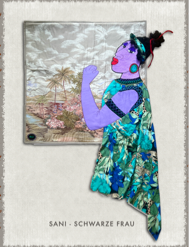
She represents many African women but also slaves, whose circumstances do not need to be explained in more detail.
The hand-embroidered face is the work of Sani - a Venda woman from South Africa: Tambani is an arts and crafts project that enables disadvantaged South African women to achieve economic independence. The women create embroidered artwork and panels depicting their traditional folk tales. These embroideries are sold all over the world.
So I incorporated this South African embroidery - the embroiderer's name is Sani Mudau - directly into my picture, giving her a hairstyle, a figure and, above all, an “attitude”. The background is freehand embroidered with a sewing machine.
Dimensions:
140 x 80 cm
Christine Brückner
(1921 - 1996)

